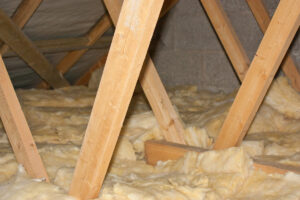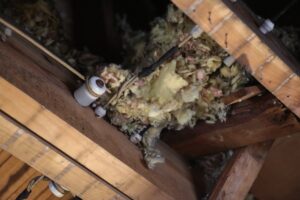Mesothelioma / Asbestos / How to Identify Asbestos / Asbestos Insulation
What Does Asbestos Insulation Look Like?
Asbestos is a mineral that’s been used to reinforce insulation for decades. Additionally, vermiculite, another mineral with fire resistant properties, was also used for insulation long before (and after) people knew it contained varying levels of asbestos. Learn how to identify the toxic minerals when manufactured into insulation products.
Get Free Mesothelioma Guide
Insulation and Asbestos Toxicity
Mostly, people know asbestos for its resistance to fire, chemical corrosion, and electricity. Manufacturers often use naturally occurring minerals like asbestos to reinforce many different types of building materials, including insulation, for decades. This was before researchers knew it was toxic to human health, and even for a long time after that. In fact, the legal use of asbestos didn’t stop until 2019. Therefore, it’s vital for property owners and real estate agents to recognize and detect materials that sometimes have asbestos and how they might appear together.
The Vermiculite and Asbestos Connection
Vermiculite is another mineral like asbestos in its resilient properties. However, it isn’t as dangerous. Manufacturers also used vermiculite to reinforce insulation for a range of products while miners supplied them with tons of the mineral they’d mine and sell to companies around the world.
There was a large vermiculite mine in Libby, Montana that at one point, made up for approximately 80% of the world’s vermiculite supply. What most didn’t know, however, was that all impure vermiculite from this mine held asbestos crystals. In fact, miners harvested impure vermiculite since 1881.
One chemical processing plant, W.R. Grace, knew about the vermiculite toxicity but reinforced their products and put their factory workers at risk for dangerous exposure to the mineral anyway. A rebrand changed vermiculite from this mine to “Zonolite” on the market. Moreover, this new zonolite was sold for a long time until the Libby mine was finally shut down in 1990.
Most toxic insulation is made of vermiculite contaminated with asbestos. The most common types of materials reinforced by the mineral with the toxin are paper, paint, adhesive, textiles, wood, drywall, or cement building items. Hot water and steam pipes, furnace ducts, attic or basement walls are the most common household structures to be aware of.
How to Identify Asbestos in Vermiculite Insulation
Most people want a quick answer for the commonly asked question, “What does asbestos insulation look like?”, but it’s not that simple. When miners find asbestos underground or in mines where it exists naturally, the mineral appears as a grayish, silver rock-crystal with closely threaded fibers attached. If circumstances disturb the fibers, they can easily detach and spread as fluffy and white tufts. Additionally, it’s basically impossible to identify asbestos once the industry mines, breaks down, colors, and manufactures asbestos or vermiculite with other materials like insulation.
Vermiculite-asbestos insulation resembles rocky gravel. It is installed by pouring it into the desired location. Insulators also refer to it as “loose-fill” and “blown-in” insulation. Colors to look out for in these pebbles are grayish, brown, or silvery gold. If your home was built before the 1990s and contains this texture and color, it may contain zonolite or some variation.
The Environmental Protection Agency (EPA) says property owners who discover potentially contaminated materials should assume it’s dangerous and find a certified, local asbestos testing company to test and verify contamination. It’s better to be certain and avoid any liabilities from injuries residents or employees may attain if they encounter dangerous levels of the toxin at work or home.
Request a case evaluation to assess your settlement options.
Evaluate My Case
Types of Insulation and Materials
Today, there are several types of insulation materials and compounds that aren’t dangerous to public health. Here are the different types and what they’re made of.
Materials
Fiberglass
Fiberglass contains small, fine glass fibers and is one of the most common insulation materials.
Cellulose
Contains approximately 85% recycled paper products. Next, manufacturers treat it with chemicals that streamline fire resistance. It comes as a liquid compound workers spray-on or in a rock-like form that insulators install behind a netting.
Mineral Wool
Another common product used in insulation, mineral wool consists of approximately 75% post-industrial recycled materials like waste matter from molten metal, or natural minerals like basalt or diabase.
Natural Fibers
Narue fibers can be cotton, sheep wool, straw, or hemp.
Plastic Fibers
Basically, pieces of plastic that manufacturers reinforce with borate. Borate is a flame-resistant compound that’s also in insect and rat repellant.
Polystyrene
A thermoplastic that lacks color and is transparent. Thermoplastics are substances that become plastic-like when insulators heat it to specific temperatures.
Polyisocyanurate
Another type of plastic, polyisocyanurate is in foam and board insulations. This material is cheap and easy to install because of its moldability.
Polyurethane
Has low-conductivity gas in its cells and is also a common material in foam linings.
Different Insulation Compounds
Loose-Fill and Blown-In Insulation
Not always made with zonolite, vermiculite, or asbestos, manufacturers also made loose-fill and blown-in insulation with other materials. Sometimes it contains cellulose, fiberglass, and mineral wool.
Blanket – Batt, and Roll
As the name implies, this type of insulation looks like a spongy, pink, or yellow blanket when found in the attic or wall spaces. Usually, batt and roll insulation encompasses fiberglass, mineral wool, plastic, and natural fibers.
Concrete Block/Forms
Insulation that encompasses concrete can work for two kinds of concrete structures, blocks, and forms. Molded expanded polystyrene (MEPs) foam insulation reinforces concrete blocks. These are recently completed, as well as existing cement infrastructures. Expanded and extruded polystyrene (EPS, XPS) and cementitious spray insulation foams protect concrete forms, or unfinished walls, foundation, and new construction.
Foam Board/Rigid Foam
Made of polystyrene, polyisocyanurate, and polyurethane, this type of insulation compound is thick and can reinforce unfinished walls, floors, ceilings, and unvented low-sloped roofs.
Spray/Cementitious Foam
As the name implies, cementitious means the foam is cement-based and comes in spray-on form. Good for enclosed walls, new wall cavities, and unfinished attic floors and walls.
Phenolic Foam
Also, a spray-on foam, phenolic compounds are more rigid and use air as the foaming agent. Phenolic foam shrinks approximately 2% once dried, which makes this material less desired by insulators. It also contains parts of cement, polyisocyanurate, polyurethane materials.
Structural Panels
Rigid panels used for insulation that have internal core reinforcement of liquid, foam insulation, or straw compounds. This type works with unfinished walls, ceilings, and floors, roofing, or new builds.
Reflective
Made with paper and plastic fibers like foil-faced kraft paper, plastic film, polyethylene bubbles, or cardboard.
Testing Your Property for Asbestos
No federal laws mandate property owners disclose the presence of asbestos in a sale. It must also be noted that while the mineral was banned in 1989, this law was overturned barely two years later in 1991. It wasn’t until 2019 that government officials outlawed most uses of the mineral. If you’re buying real estate, especially property made before the 90s, hire a certified company to test for it.
The EPA suggests testing for asbestos or zonolite in homes when the potential buyers discover worn-down tiles, pipes, insulation, or other products. This is because when manufacturers produce products with asbestos or zonolite, it’s almost impossible to see it by just looking. Additionally, it’s dangerous to spend time trying to identify the mineral – inhalation of its toxic fibers can cause latent illnesses and cancers like mesothelioma.
What Should I Do If I Find Vermiculite-Asbestos Insulation?
If you know or suspect the existence of the toxin in your insulation or anywhere else, the EPA recommends property owners not handle it themselves. After an accredited organization determines contamination, you should hire a certified asbestos removal company to either completely remove or encapsulate (cover) asbestos materials.
Anyone who gets latent illness from toxic exposure can sue the person or company responsible. Contact Mesothelioma Hub and let us aid you.
Mesothelioma Support Team
Mesothelioma Hub is dedicated to helping you find information, support, and advice. Reach out any time!

